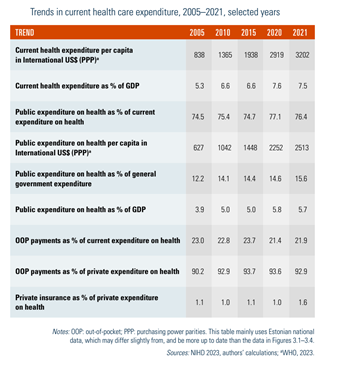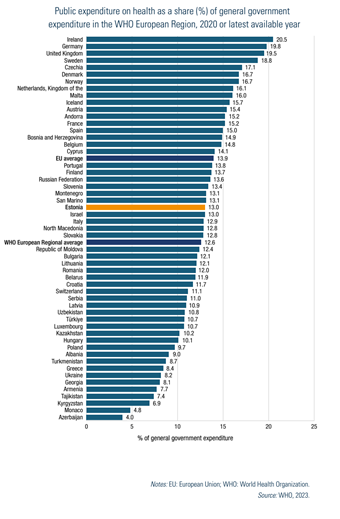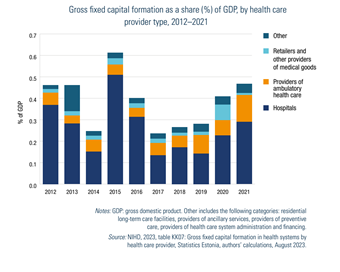-
29 November 2024 | Country Update
Increased public health expenditure in 2023 highlights the impact of wage pressures -
19 January 2024 | Country Update
Current health expenditure in 2022: Back to business-as-usual
3.1. Health expenditure
In 2021, Estonia spent 7.5% of its GDP on health. Health care is largely publicly financed (76.4% in 2021), but 21.9% of health expenditure comes from private sources, mainly OOP payments, whereas the role of private insurance is negligible (1.6% of private expenditure on health) (see Table3.1). Since 2003, the NIHD has been following the international System of Health Accounts 2011 methodology for calculating the health expenditure.
Table3.1
From an international perspective, the level of health expenditure as a share of GDP in Estonia is below the average for the WHO European Region (Fig3.1), but it has increased steadily since 2015 (Fig3.2). Part of the increase is related to the additional transfers from the central government budget to the EHIF from 2018 (see section 3.2 Sources of revenue and financial flows). Fluctuations in the trend can be attributed to the financial crisis in 2009–2011, when the economy declined more than public health expenditure, and to the COVID-19 pandemic in 2020–2021, which increased public health expenditure while the economy compressed. A similar impact of the crises can also be observed in other EU Member States (Fig3.2).
| Fig3.1 | Fig3.2 |
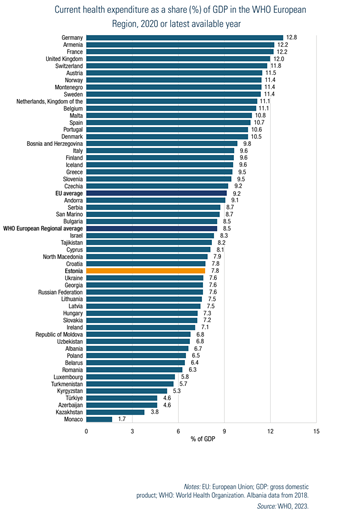 |  |
Current health care expenditure per capita adjusted for differences in purchasing power has increased from a low of US$ 838 in 2005 to US$ 2919 in 2020 and US$ 3202 in 2021 (Table3.1). In 2020, the per capita spending was at a similar level to Lithuania but higher than in Latvia and also higher than in some central European countries such as Hungary, Slovakia and Poland (Fig3.3). The share of public spending in current health care expenditure in Estonia is 77%, higher than in other Baltic states (Fig3.4).
| Fig3.3 | Fig3.4 |
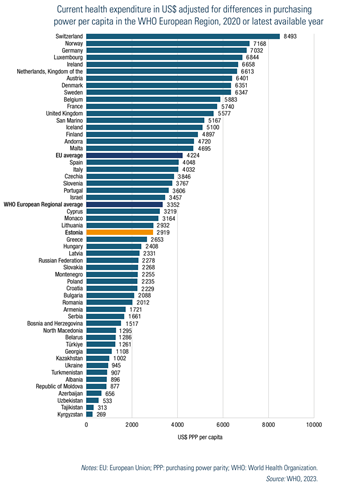 | 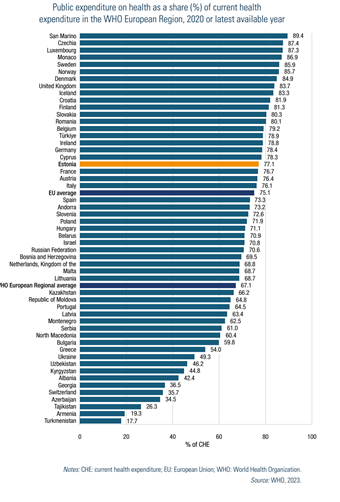 |
According to the national statistics, public expenditure on health as a share of general government expenditure gradually increased, from 12.2% in 2005 to 14.6% in 2020 and 15.6% in 2021. The increases in 2020 and 2021 can be explained by extraordinary spending on COVID-19-related care (Table3.1). The rising share of public health expenditure within total government spending underscores the government’s growing emphasis on health care. However, since the government’s spending as a percentage of the economy lags behind the EU average, the aggregate public health expenditure similarly remains below the EU average.
Internationally comparable expenditure data reported to the Global Health Expenditure Database (WHO, 2023) reflect the growth of public health expenditure as a share of general government expenditure in Estonia, but at a lower rate – 13% in 2020, which is below the EU average of 13.9% (Fig3.5).
Fig3.5
In addition to current health expenditure, there is capital investment by health care providers. Total gross fixed capital formation varied between 0.2% and 0.6% of GDP in 2012–2020 or about 4–9% of current health expenditure (Fig3.6). The majority of investments are usually made by hospitals (see section 3.6.2 External sources of funds).
Fig3.6
In 2023, current health expenditure amounted to 7.5% of GDP, matching the levels observed during the COVID-19 peak in 2020 and 2021. In absolute terms, health spending reached EUR 2.85 billion, reflecting an annual increase of EUR 325 million (equivalent to 12.9% growth).
While the rapid increase in healthcare costs in 2020 and 2021 was primarily due to additional expenses incurred during the COVID-19 crisis, the situation in 2022 began to return to pre-pandemic conditions. However, in 2023, expenditure once again increased significantly, primarily driven by rising wages of healthcare professionals. On 1 April 2023, the minimum hourly wages for doctors and nurses increased by 20%, as per collective agreements. The actual increase in hourly wages was even higher, amounting to approximately 25% for doctors and 21% for nurses, as observed from a comparison between wages in March 2024 and March 2023.
Public sector expenditure accounted for 76% of total healthcare costs in 2023. The Estonian Health Insurance Fund (EHIF) covered 67% of healthcare expenditure, returning to its pre-COVID-19 share. Meanwhile, the share of central government expenditure continued to decline (from 7% in 2022 to 5% in 2023), while the contribution of local governments increased marginally from 3% to 4%.
The share of out-of-pocket (OOP) payments in healthcare expenditure slightly declined to 22.1% in 2023 (from 23.1% in 2022), aligning closely with its average over the past five years. The largest components of OOP payments were dental care (33% of OOP), long-term care (17%), prescription medicines (15%), over-the-counter (OTC) medicines (12%), and outpatient specialist care (11%). Interestingly, although expenditure on prescription drugs increased by 15%, there was no corresponding increase in spending on OTC medicines, which instead saw a slight decline of 1%.
The share of voluntary healthcare financing (including voluntary health insurance, non-governmental organizations, and enterprises) in total healthcare expenditure remained negligible but stable at 2.1% in 2023. The role of voluntary health insurance continued to be minimal at 0.9%, showing a slight increase from 0.7% in 2022.
Authors
References
- National Institute for Health Development “Health expenditure in Estonia 2023”, press release 25 November 2024 https://tai.ee/et/uudised/avaliku-sektori-tervishoiukulude-kasv-uletas-leibkondade-omaosaluse-kasvu-2023-aastal
- National Institute for Health Development, Health Statistics and Health Research Database, table KK01: Current health expenditure by health care function and financing scheme https://statistika.tai.ee/pxweb/en/Andmebaas/Andmebaas__04THressursid__10Tervishoiukulud/KK01.px
- National Institute for Health Development, Health Statistics and Health Research Database, table TT04: Gross hourly and monthly wage of health care personnel by occupation https://statistika.tai.ee/pxweb/et/Andmebaas/Andmebaas__04THressursid__06THTootajatePalk/TT04.px
In 2022, Estonia returned to pre-pandemic level in health spending with current health expenditure (CHE) falling to 7.1% of GDP from a high of 7.6% in the COVID-19 peak years of 2020 and 2021. In absolute terms, €2.54 billion was spent on health, €180 million more than in the previous year – an increase of 7.6%.
Additional expenses, incurred due to the COVID-19 crisis, led to increased healthcare costs in 2020 and 2021. Although the need to compensate for pandemic-related costs eased in 2022, inflationary pressure on employee salaries and rising energy prices increased. In 2022, three quarters of health expenditure came from the public sector. Even though the expenditure by the Estonian Health Insurance Fund (EHIF) and local governments increased, the role of central government expenditure decreased, as COVID-19 vaccination and surveillance costs diminished. As a result, spending on prevention activities decreased from 8.8% of CHE in 2021 to 6.1% in 2022.
In addition, the share of out-of-pocket (OOP) payments rose slightly to 23.2% of CHE (from 22.5% in 2021), which is close to the 10-year average of 23.5%. The largest share of OOP expenditure is still dental care (32%), followed by prescription and over-the-counter medicines (14% and 12%, respectively), long-term care (18%) and outpatient specialist care (11%).
Finally, there’s a small increase in voluntary health funding (VHI, NGOs, enterprises), which rose from 1.7% in 2021 to 2.0% in 2022. Although the role of VHI remains small at 0.7%, it has doubled since 2021.
References
National Institute for Health Development “Health expenditure in Estonia 2021”, press release 23 November 2023: https://tai.ee/et/uudised/leibkondade-omaosalus-tervishoiukuludes-jatkas-tousu-2022-aastal
National Institute for Health Development, Health Statistics and Health Research Database, table KK01: Current health expenditure by health care function and financing scheme https://statistika.tai.ee/pxweb/en/Andmebaas/Andmebaas__04THressursid__10Tervishoiukulud/KK01.px

